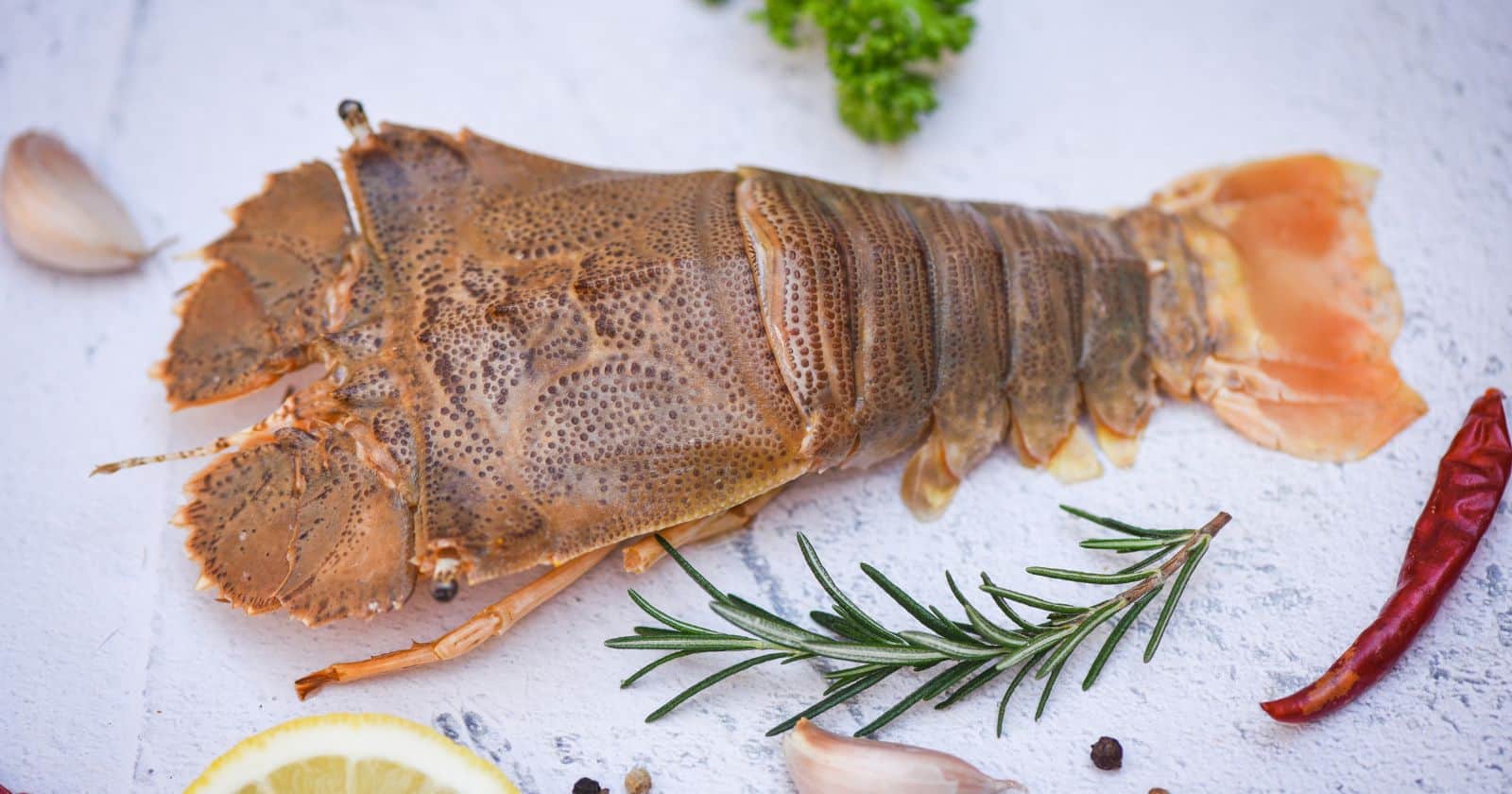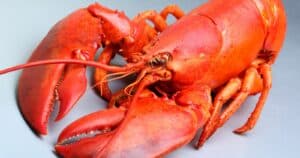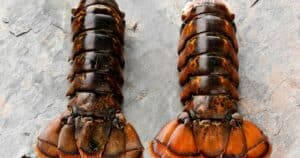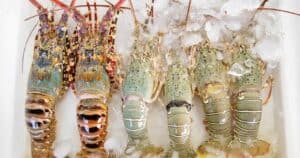Do you love lobster but always wondered if they have bones? Well, you’re not alone. It’s a common misconception that lobsters must have bones like most animals. However, the truth is quite fascinating. Not only do lobsters lack bones, but they also have a unique way of growing that may surprise you.
The answer is straightforward. Lobsters do not have bones. Invertebrate crustaceans rely on their exoskeleton, a hard outer shell, for support and protection. This shell is essential for survival, and lobsters cannot grow without shedding it. This process, called molting, allows them to develop a more extensive and robust exoskeleton. Surprisingly, this can happen up to 25 times in a lobster’s lifetime.
In the following sections, we’ll explore more details about the lobster’s exoskeleton, how they go about molting, and its implications for their survival. We’ll also touch on related crustaceans like shrimp and crabs and how they lack bones.
By the end of this article, you’ll better understand and appreciate these fascinating creatures.
The Anatomy of a Lobster: Understanding their Exoskeleton
Lobsters do have a type of skeleton, but it’s not like the bones in your body. Lobsters are invertebrate crustaceans, which means they don’t have a backbone as you do. Instead, their skeleton is called an exoskeleton, a hard outer shell made of chitin, a protein found in human nails.
The exoskeleton of a lobster is a fantastic piece of biological engineering. It not only protects from predators and the elements, but it also allows the lobster to move around and catch prey. The exoskeleton comprises jointed segments, which gives the lobster flexibility.
Lobsters grow by shedding their exoskeleton, a process called molting. When a lobster molts, it sheds its old exoskeleton and produces a new one. This process can take several weeks, during which the lobster is very vulnerable.
Recent research has revealed that lobsters have the potential to record composition systematics within their biominerals. This means that the minerals in their exoskeleton could be used for scientific study, giving researchers insights into the past environment and climate.
In addition to their exoskeleton, lobsters have several other fascinating anatomical features. They have two large claws, one for crushing and one for cutting, which they use to catch and eat their prey. They also have a segmented body with a long tail and several tiny legs, which they use to walk and swim.
How do Lobsters Grow Without Bones?
Lobsters don’t have bones as humans do – instead, they have a sturdy exoskeleton that protects their bodies. But how do they grow if they can’t simply expand their bones as we can? Well, the answer lies in molting. Essentially, lobsters shed their exoskeletons periodically throughout their lives in a process called molting.
Before doing so, they absorb water through their gut, causing their new exoskeleton to swell. This new exoskeleton isn’t flexible enough to grow with the lobster, so it must shed its old one and crawl out of it before it can continue growing.
But molting is no small task for lobsters – it takes a lot of energy and preparation. Here are a few more details about how lobsters grow without bones:
- Molting typically begins around September for juvenile lobsters and continues throughout their lives.
- Before a lobster molts, it will stop eating and become less active, partly because it’s building up energy reserves for the upcoming molting process.
- Once it’s time to molt, a lobster secrete enzymes that dissolve the base of its old exoskeleton, separating it from the underlying skin.
- Then, the lobster will swell up with water to break apart the exoskeleton and slip out of it. This process takes around 30 minutes.
- Once the lobster has shed its old exoskeleton, it has a soft, vulnerable body that must harden quickly to avoid predators. The new exoskeleton takes around two weeks to fully set.
All in all, the molting process is a crucial part of a lobster’s growth and survival. Without it, their rigid exoskeletons would prevent them from growing and thriving in their environments.
The Molting Process and its Importance
The molting process is essential for the growth and development of lobsters. Lobsters do not have bones like humans. Instead, they have exoskeletons that protect their soft bodies. As lobsters grow, their exoskeletons become too small, and they must molt to shed their outer shells and grow new ones. This process is vital as it enables them to develop, repair damage, and replace lost limbs.
During molting, lobsters absorb water to expand their new exoskeletons gradually. This process can take several hours or even days, depending on the size and age of the lobster. After molting, lobsters become vulnerable as their new shells are soft and fragile. To protect themselves, lobsters will often hide until their new shells harden.
Molting is not only crucial for the growth and development of lobsters, but it also plays a significant role in their survival. When a lobster molts, it eliminates any parasites or bacteria that may have been living in or on its old exoskeleton. This helps reduce the risk of diseases and infections that could harm or even kill the lobster.
In addition, the molting process is essential to lobster fishermen. During the molting season, lobsters become more active and are more likely to search for food. This makes them more susceptible to traps, making it easier for fishermen to catch them. However, fishermen must also be aware of the molting process and avoid catching lobsters when they are vulnerable.
What Happens to a Lobster After Molting
Adult lobsters usually molt once a year to once every two years. During molting, lobsters absorb water through their gut, causing their new exoskeleton to expand. They regenerate lost limbs because they shed their exoskeleton and grow a new ones. Before molting, a hormonal change softens the exoskeleton causing it to detach from the abdomen. After molting, a lobster becomes ravenous and consumes the shells it has just shed.
During molting, lobsters are particularly vulnerable and hide away in crevices for protection. Once the lobster has entirely shed its old exoskeleton, it begins to harden again. The new exoskeleton is weak and pale in color, unlike the complex and vibrant shell that a lobster usually sports.
The whole molting process can take up to two days. After molting, lobsters need several weeks to harden completely, during which time the lobster is sluggish and vulnerable to predators. They are prone to growing in weight immediately after molting, which indicates they have also grown in size.
Other Crustaceans Without Bones: Shrimp and Crabs
Do shrimp and crabs have bones? No, they don’t! These tasty crustaceans, like lobsters, don’t have bones. They have an exoskeleton made of a material similar to human bones. But, unlike us, these critters don’t need the backbone to move around. Instead, their exoskeleton acts as protective armor, making them strong and flexible.
So, what makes shrimp and crabs different from lobsters? They’re smaller (although some crabs can grow quite large). They also have some unique features, such as:
- Shrimp have long antennae that help them navigate in the water.
- Crabs have a pair of claws that they use for defense and to catch their prey.
- Both shrimp and crabs have compound eyes, which are made up of many tiny lenses that allow them to see in multiple directions.
Despite their differences, shrimp, crabs, and lobsters share some attractive traits. For example:
- They all have to molt or shed their exoskeleton to grow. During this process, they’re vulnerable to predators and must hide until their new exoskeleton hardens.
- They’re all scavengers, meaning they eat both plants and animals. Some species are also opportunistic and will eat anything they can find.
Finally, it’s important to note that these crustaceans are essential to our oceanic ecosystem. They help keep the food chain balanced as predators and prey. So next time you enjoy some shrimp or crab, consider all the interesting facts behind these creatures!
The Benefits and Drawbacks of an Exoskeleton
Benefits:
- Protection against predators and physical damage: Lobsters’ hard exoskeletons protect them from being eaten by predators or damaged by sharp objects.
- Flexibility: The many points of muscle attachment on the exoskeleton allow lobsters to move in complex ways with jointed appendages.
- Strength: The exoskeleton provides a solid support structure for the lobster’s body.
Drawbacks:
- Size limitation: The exoskeleton cannot grow with the lobster’s body, so as it grows, it must periodically molt and wait for a new exoskeleton to form. This limits the size of lobsters and other arthropods.
- Vulnerability during molting: During the molting process, lobsters are very vulnerable to predators and may die if they are not careful.
- Increased energy demands: Maintaining the exoskeleton requires significant energy, which can limit lobsters’ ability to do other things like hunting for food or mating.
Despite these drawbacks, lobsters and other animals with exoskeletons have evolved to take advantage of their protective benefits and overcome their limitations. They can continue surviving and thriving in their environments by shedding their old exoskeletons and growing new ones.
The Role of the Exoskeleton in Lobster’s Survival
The exoskeleton serves as both armor and mobility boost for lobsters. It protects against predators and physical damage while allowing complex movements and flexibility. This hard outer shell is like a knight’s armor, covering the lobster’s entire body. But unlike a rigid set of metal plates, the exoskeleton is incredibly lightweight, allowing lobsters to move swiftly and quickly through their underwater habitat.
The exoskeleton is also vital in protecting the lobster from water loss and desiccation. If a lobster’s exoskeleton becomes damaged, it can threaten its survival. Without this protective layer, they would lose precious body fluids, quickly rendering them weak and vulnerable.
One of the most exciting features of the lobster exoskeleton is that it’s entirely flexible. Unlike other animals’ hard, unyielding bones, the exoskeleton provides a large surface area for muscle attachment, allowing for highly complex movements. The flexibility of the exoskeleton is essential for lobsters’ survival, as it helps them evade predators and navigate rugged terrain in their underwater environment.
Overall, the role of the exoskeleton in lobster survival cannot be overstated. It is an essential part of their unique anatomy, providing the necessary protection and flexibility for them to thrive in their habitat. Without it, lobsters would be unable to move effectively, protect themselves, and maintain vital body fluids – and they would be in much trouble!





